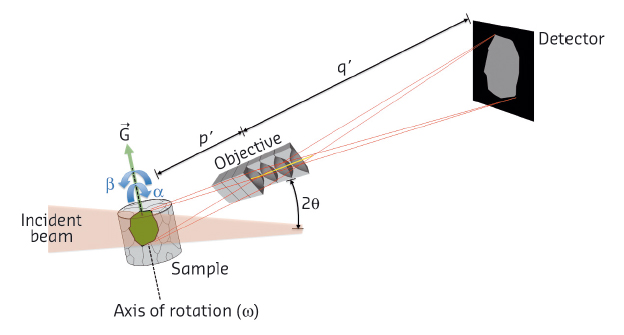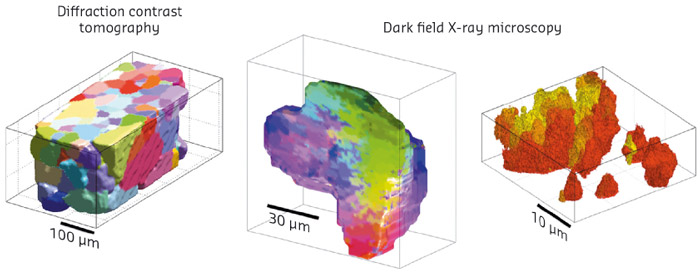- Home
- Users & Science
- Scientific Documentation
- ESRF Highlights
- ESRF Highlights 2015
- Enabling technologies
- Diffraction based transmission X-ray microscopy
Diffraction based transmission X-ray microscopy
Dark field X-ray microscopy is a new type of microscopy that enables the user to zoom in on internal parts of mm-sized crystalline samples and provides 3D maps of the local structure. By varying the degree of the zoom one can visualise the entire specimen, grains, domains or even individual defects. With ample space around the sample, the method is capable of acquiring 3D movies of changes inside components while they are processed by real-life sample environments.
Most materials and minerals are comprised of hierarchical crystalline structures and sub-structures such as grains, domains and atomic-scale defect networks. For both materials and geological sciences, it would be highly beneficial to be able to understand and model the interplay of physical phenomena and structural dynamics at and between many different length scales. With this capability, the final macroscopic properties of a material could be predicted from the initial microstructure and processing conditions, and materials could be designed and optimised using computer simulations rather than experimental trial-and-error. To guide such efforts, experimental techniques are needed that can rapidly swap between the different length scales and make in situ, three-dimensional (3D) movies of the local changes to the crystalline lattice: structure, strain and orientation.
To facilitate such studies, a prototype diffraction based transmission X-ray microscope is being developed at the Technique and Instrumentation Test Beamline, ID06. It operates in the 15-30 keV range. At the coarse end of the scale, 3D grain mapping techniques such as 3-dimensional X-ray diffraction (3DXRD) [1] and diffraction contrast tomography (DCT) are implemented for fast overviews of mm-sized specimens. Once a particular grain of interest has been selected, detailed studies are performed by dark-field X-ray microscopy, a new full-field imaging technique for non-destructive mapping (Figure 147). By placing an X-ray objective lens in the diffracted beam, users can intuitively ‘zoom’ between different length scales by changing the objective focal length, overcoming the spatial bandwidth limitations of other techniques. The objective also filters stray diffraction signals, suppressing unwanted overlap and isolating the individual structural element of interest. The sample-to-detector distance is typically 2-6 m, enabling magnification ratios of up to 50 while still maintaining sufficient space around the sample for in situ apparatus. Like the electron microscope, the dark-field microscope can be operated in a variety of modes. Maps of the axial strain can be measured by scanning the objective and detector through 2θ, while the local misorientation can be similarly mapped by stepping the sample through two orthogonal tilt directions, (α,β).
 |
|
Fig. 147: Principle of dark-field X-ray microscopy. |
3D measurements of axial strain and orientation can be obtained in two ways. Firstly, by using a one-dimensionally-focusing condenser to create a narrow line-beam which illuminates a ‘slice’ of the material, which is then imaged at an oblique angle. A 3D volume is then obtained layer-by-layer. A second, faster, method involves illuminating the entire grain and recording projections from different viewing angles while rotating the sample around the scattering-vector,  . 3D reconstruction can then be accomplished by tomographic type algorithms [2].
. 3D reconstruction can then be accomplished by tomographic type algorithms [2].
 |
|
Fig. 148: Multiscale mapping of 10% tensile deformed aluminium. The colours symbolise orientations. |
This concept of multiscale mapping was used for an annealing study of a plastically deformed Al sample. Shown in Figure 148 left is part of a DCT mapping of all grains in the specimen. Zooming in on one embedded grain, the intrinsic variation in orientation was then mapped. A vertical section through the grain is shown in Figure 148 middle. Finally by zooming once more, individual sub-grains were mapped in 3D (Figure 148 right). From left to right in the figure, the spatial resolution is 3.5 µm, 1.5 µm and 300 nm, and the angular resolution 0.5°, 0.15° and 0.03°, respectively.
Next the subgrain dynamics was tracked as function of time during annealing. The results are consistent with conjectures in the literature of subgrain growth by subgrain boundary motion, but this is the first time the processes have been directly verified and quantified.
Based on the principle illustrated above, a dedicated transmission X-ray microscope will be commissioned at beamline ID06 in 2016 with a target resolution of 50 nm.
Principal publication and authors
Dark-field X-ray microscopy for multiscale structural characterization, H. Simons (a,b), A. King (b), W. Ludwig (c), C. Detlefs (b), W. Pantleon, (d), S. Schmidt (a), F. Stöhr (e), I. Snigireva (b), A. Snigirev (b) and H.F. Poulsen (a). Nature Communications 6, 6098 (2015); doi: 10.1038/ncomms7098.
(a) Department of Physics, DTU, Lyngby (Denmark)
(b) ESRF
(c) MATEIS, INSA-Lyon (France)
(d) Department of Mechanical Engineering, DTU, Lyngby (Denmark)
(e) DTU Danchip, Lyngby (Denmark)
References
[1] H.F. Poulsen, Three-dimensional x-ray diffraction microscopy (Springer, 2004).
[2] W. Ludwig et al., J. Appl. Cryst. 34, 602–607 (2001).



